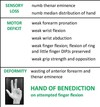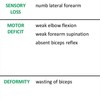Year 2 Flashcards
(132 cards)
Name the genetic condition associated with the following tumours:
Thyroid: medullary thyroid cancer
Adrenal: pheochromocytoma
Parathyroid: hyperplasia/adenomas
MEN2a
Describe the pathophysiology of pemphigus vulgaris
Type II hypersensitivity - IgG4 antibodies against desmosomal proteins leads to loss of keratinocyte adhesion in the skin and mucous membranes, leading to superficial blisters, erosions, and mucosal ulcers
In _____________ hyperparathyroidism, caused by a autonomous parathyroid following years of renal failure, PTH will be high and calcium will be high
Tertiary
What hearing test results (using a tuning fork) would indicate sensorineural hearing loss?
Air conduction > bone conduction (Rinne’s)
Head in good ear (Webers)
Name the genetic condition associated with the following tumours:
Thyroid: medullary thyroid cancer
Adrenal: pheochromocytoma
Parathyroid: hyperplasia/adenomas
Mucosal neuromas
MEN2b
Vertical double vision with hypertropia/hypotropia on cover test suggests a problem with which of the ocular muscles?
SO, SR, IR, IO
What is nephrotic syndrome?
Indicative of a non-proliferative process affecting podocytes
Clinical features:
- Heavy proteinuria (> 3 g/day)
- Hypoalbuminaemia
- Non-dependent oedema, classically periorbital
Name the enzyme deficient in acute intermittent porphyria, and the porphyrin which will accumulate as a result
Porphobilinogen deaminase, porphobilinogen
Which condition is associated with anti-centromere antibody?
Limited systemic sclerosis
Which cranial nerve supplies all the extraocular muscles except the superior oblique and lateral rectus?
CN III - oculomotor
Where is the lesion? Name the defect

Lesion of optic nerve → ipsilateral monocular visual loss
A patient with CN _____ palsy typically presents with horizontal diplopia which is worsened when they attempt to look towards the affected side; unopposed adduction of the eye results in a convergent squint or esotropia (eye turns inwards)
CN VI

Describe the mechanism of action of SGLT2 inhibitors
Lower renal threshold for glucose so increase urinary glucose excretion
Describe the clinical presentation of a meniscal tear
Pain and tenderness localised to joint line (medial or lateral)
Usually twisting sports injury in younger patients
What is Anderson-Fabry’s disease?
X-linked lysosomal storage disease - inborn error of glycosphingolipid metabolism (deficiency of ⍺-galactosidase A)
Describe the clinical presentation of Alport’s syndrome
Suspect in patients with microscopic haematuria +/- hearing loss in the early years
Proteinuria seen later but confers bad prognosis
Injury to which nerve results in wrist drop?
Radial nerve
What hearing test results (using a tuning fork) would indicate conductive hearing loss?
Bone conduction > air conduction (Rinne’s)
Head in bad ear (Webers)
Which nerves can be damaged by a supracondylar fracture of the humerus?
Median, ulnar
What is the most common cause of nephrotic syndrome in adults?
Focal segmental glomerulosclerosis
How would you manage an intracapsular hip fracture in a previously low-functioning patient?
Hemi-arthroplasty
Describe the usual mechanism of injury of a PCL injury
Tend to occur following a direct blow to anterior tibia (e.g. dashboard, motorbike)
How would you manage a displaced intracapsular fracture in a previously high-functioning patient?
Total hip replacement
Cover test: uncovered eye moves up
Hypertropia


















